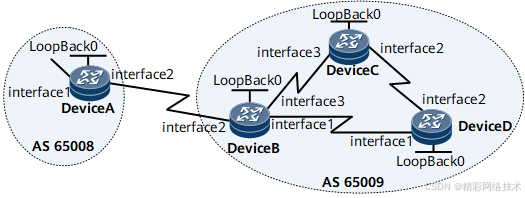学习精彩网络技术老师:华为HCIA和HCIP数通eNSP实战视频课、华三、锐捷、WLAN、IPv6等全套视频课程
配置BGP的基本功能后可以组建BGP网络。
组网需求
某个地区拥有多个AS,AS之间有相互访问的需求,因此需要AS之间相互交换本AS内部的路由。由于AS内NE数量众多,导致路由数量较大,路由变化频繁,如何高效率的在AS之间传递大量路由,并且不占用大量带宽成为一个难题。为解决上述问题,可以使用BGP协议。
如图1所示,DeviceA处于AS65008,DeviceB、DeviceC和DeviceD处于AS65009,并且这几个NE的路由数量都比较大,路由表变化频繁。在这几个NE上部署BGP协议之后,NE之间可以相互传递路由,并且当任何一个NE有路由更新时,只需发送路由更新信息给邻居NE,而无须发送整个路由表,大大节约了网络带宽。

本例中interface1,interface2,interface3分别代表GE0/1/0,GE0/2/0,GE0/3/0。
| 设备名称 |
接口 |
IP地址 |
| DeviceA |
Loopback 0 |
1.1.1.1/32 |
| GE 0/1/0 |
172.16.0.1/16 |
|
| GE 0/2/0 |
192.168.0.1/24 |
|
| DeviceB |
Loopback 0 |
2.2.2.2/32 |
| GE 0/1/0 |
10.1.1.1/24 |
|
| GE 0/2/0 |
192.168.0.2/24 |
|
| GE 0/3/0 |
10.1.3.1/24 |
|
| DeviceC |
Loopback 0 |
3.3.3.3/32 |
| GE 0/2/0 |
10.1.2.1/24 |
|
| GE 0/3/0 |
10.1.3.2/24 |
|
| DeviceD |
Loopback 0 |
4.4.4.4/32 |
| GE 0/1/0 |
10.1.1.2/24 |
|
| GE 0/2/0 |
10.1.2.2/24 |
配置注意事项
在配置过程中,需注意以下事项:
建立对等体时,当所指定的对等体的IP地址为Loopback接口地址或子接口的IP地址时,需要在对等体两端同时配置命令peer connect-interface,以保证两端连接的正确性。
EBGP对等体之间不是直连的物理链路时,则必须使用peer ebgp-max-hop命令允许它们之间经过多跳建立TCP连接。
配置思路
采用如下的思路配置BGP的基本功能:
在DeviceB、DeviceC、DeviceD之间配置IBGP连接。
在DeviceA和DeviceB之间配置EBGP连接。
在DeviceA上通过network命令发布路由,查看DeviceA、DeviceB、DeviceC的路由表信息。
在DeviceB上配置BGP引入直连路由,查看DeviceA、DeviceC的路由表信息。
数据准备
为完成此配置例,需准备如下的数据:
DeviceA的Router ID以及所在的AS号。
DeviceB、DeviceC、DeviceD的Router ID以及所在的AS号。
操作步骤
- 配置各接口的IP地址,请参见配置文件
- 配置OSPF
# 配置DeviceB。
[~DeviceB] ospf 1
[*DeviceB-ospf-1] area 0
[*DeviceB-ospf-1-area-0.0.0.0] network 10.1.1.0 0.0.0.255
[*DeviceB-ospf-1-area-0.0.0.0] network 10.1.3.0 0.0.0.255
[*DeviceB-ospf-1-area-0.0.0.0] network 2.2.2.2 0.0.0.0
[*DeviceB-ospf-1-area-0.0.0.0] commit
[~DeviceB-ospf-1-area-0.0.0.0] quit
[~DeviceB-ospf-1] quit
# 配置DeviceC。
[~DeviceC] ospf 1
[*DeviceC-ospf-1] area 0
[*DeviceC-ospf-1-area-0.0.0.0] network 10.1.2.0 0.0.0.255
[*DeviceC-ospf-1-area-0.0.0.0] network 10.1.3.0 0.0.0.255
[*DeviceC-ospf-1-area-0.0.0.0] network 3.3.3.3 0.0.0.0
[*DeviceC-ospf-1-area-0.0.0.0] commit
[~DeviceC-ospf-1-area-0.0.0.0] quit
[~DeviceC-ospf-1] quit
# 配置DeviceD。
[~DeviceD] ospf 1
[*DeviceD-ospf-1] area 0
[*DeviceD-ospf-1-area-0.0.0.0] network 10.1.1.0 0.0.0.255
[*DeviceD-ospf-1-area-0.0.0.0] network 10.1.2.0 0.0.0.255
[*DeviceD-ospf-1-area-0.0.0.0] network 4.4.4.4 0.0.0.0
[*DeviceD-ospf-1-area-0.0.0.0] commit
[~DeviceD-ospf-1-area-0.0.0.0] quit
[~DeviceD-ospf-1] quit
- 配置IBGP连接
# 配置DeviceB。





 最低0.47元/天 解锁文章
最低0.47元/天 解锁文章


















 1058
1058

 被折叠的 条评论
为什么被折叠?
被折叠的 条评论
为什么被折叠?










